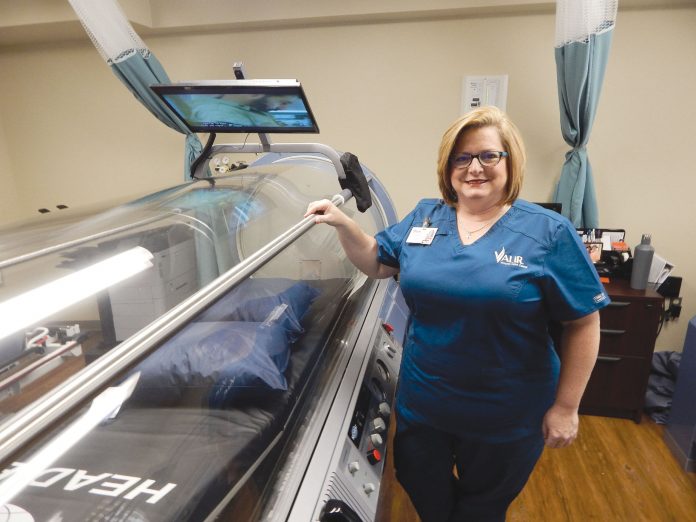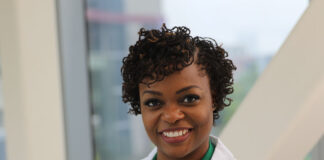
by James Coburn
Staff Writer
The Valir Wound Care & Hyperbarics Center opened in early June in midtown Oklahoma City, said Shelli Freeman, RN and clinical nurse manager and a wound care certified nurse.
The Wound Care Team is participating in the “White Sock Campaign” September’s Peripheral Artery Disease Awareness Month, an effort that ordinated to raise awareness for diabetes, peripheral arterial disease, PAD, and the prevention of amputation.
This month, Valir is raising awareness around PAD, a condition that causes narrowing of the peripheral arteries and restricts blood flow throughout the body. PAD is most common in the legs, where blocked vessels can cause sores and foot ulcers. These sores can result in amputation if not treated properly.
Set inside Valir Rehabilitation Hospital, all wound care patients at Valir Wound Care & Hyperbarics Center are seen by a physician. There are three treatment rooms where they render complete patient assessments for nutrition, vascular and lifestyle to determine what is causing the wounds. Adjustments may be made to help patients in their healing process, Freeman said.
One of the adjunct therapies available in the wound care center is hyperbaric oxygen treatments. Two hyperbaric chambers are used for different modalities.
“Some primary indications are diabetic foot ulcers that are not healing, infection of the bone and a list of other things that are determined appropriate for hyperbaric oxygen treatment,” she said.
The treatment works well with bio-therapy skin grafts, burns, surgical debreivements, compression wraps and different modalities to help wound heal, Freeman said. A car accident or a fall may lead to a serious wound.
“Especially in Oklahoma we know that we have a large percentage of our population that are diabetics,” Freeman said. “Diabetics do not heal as fast as the average person does. So with that being said with the high number of diabetics we also have a large number of non-healing wounds.”
Most wounds are difficult to heal not only due to diabetes, but because of respiratory problems and medications used for treatment.
Freeman said the goal of Valir Wound Care & Hyperbarics Center is to help everyone with non-healing wounds to heal faster. Decreasing the number of amputations is a factor in improving wound-care patients’ quality of life, she said.
The clinic has a unique opportunity of presenting more than 150 years of specific wound care experience. This is very special.
“Not a lot of centers can say that,” Freeman said.
The process of hyperbarics brings to use 100 percent oxygen that is under compression. The chamber is equivalent to being 33 feet below sea level, or two-and-a-half atmospheres below sea level.
“That compression breaks the oxygen down in smaller particles where not only the red blood cells can carry the oxygen but the plasma can be absorbed,” Freeman explained. “That along with vasodialation, aids in getting blood, oxygen and maybe antibiotics to areas that had been restricted prior to the treatment.”
An average treatment span for hyperbarics is between 20 to 40 treatments. The treatments are everyday, Monday through Friday, Freeman said. A single visit is approximately two hours long. The beneficial treatment is about 90 minutes depending on specific orders, she said.
Comfort is an important factor at the Valir Wound Care & Hyperbarics Center. Patients may watch a video or movie they bring from home during their treatment time. Each chamber is equipped with a television screen for viewing pleasure.
They can also watch material provided by the clinic. Many patients have started a Netflix series to view entirely during the duration of treatment.
“We encourage them to watch a movie or see themselves as lying on their couch during their treatment for the day and not focus on the fact that they are inside the chamber,” Freeman said. “They can relax, enjoy their movie or take a nap.”
“Our hyperbaric technician has over 17 years experience. He is compassionate to the patients and is there for their every need.”
Other types of wound care are available. After doing a full assessment, there are nine essential steps of wound healing that are considered.
Different modalities are typically the debreivements, topical ointments and dressings. A debreivement is a surgical procedure a physician renders at the bedside with a topical anesthetic.
“It’s a process where the surgeon removes the non-viable tissue,” Freeman said. “It allows to get the bad stuff out and the body to heal itself.”
Freeman said she has a personal investment in the entire industry of healing wounds. She decided early in life to become a nurse when seeing how diabetes impacted her father’s life.
“So I had grown up with a diabetic father and the affects that had not only on him but the entire family,” Freeman said.
While earning her nursing degree at Seminole State University, Freeman learned how diabetes affects a patient in a myriad of ways. Wound care with diabetes has a major impact on life, she said.
“I became very passionate and saw the need to learn as much about that as possible to help my own father as he progressed through his disease process,” Freeman said. “And I look at every patient that comes in as someone’s mother, father, son or daughter.”
She treats them as family. The staff doesn’t look at the hole in the patient. They look at the whole patient. They know that the wound affects their entire lifestyle.
“I really try to look at that component of each patient that walks through the door,” Freeman said. “I take a personal investment in seeing their quality of life improve.”












